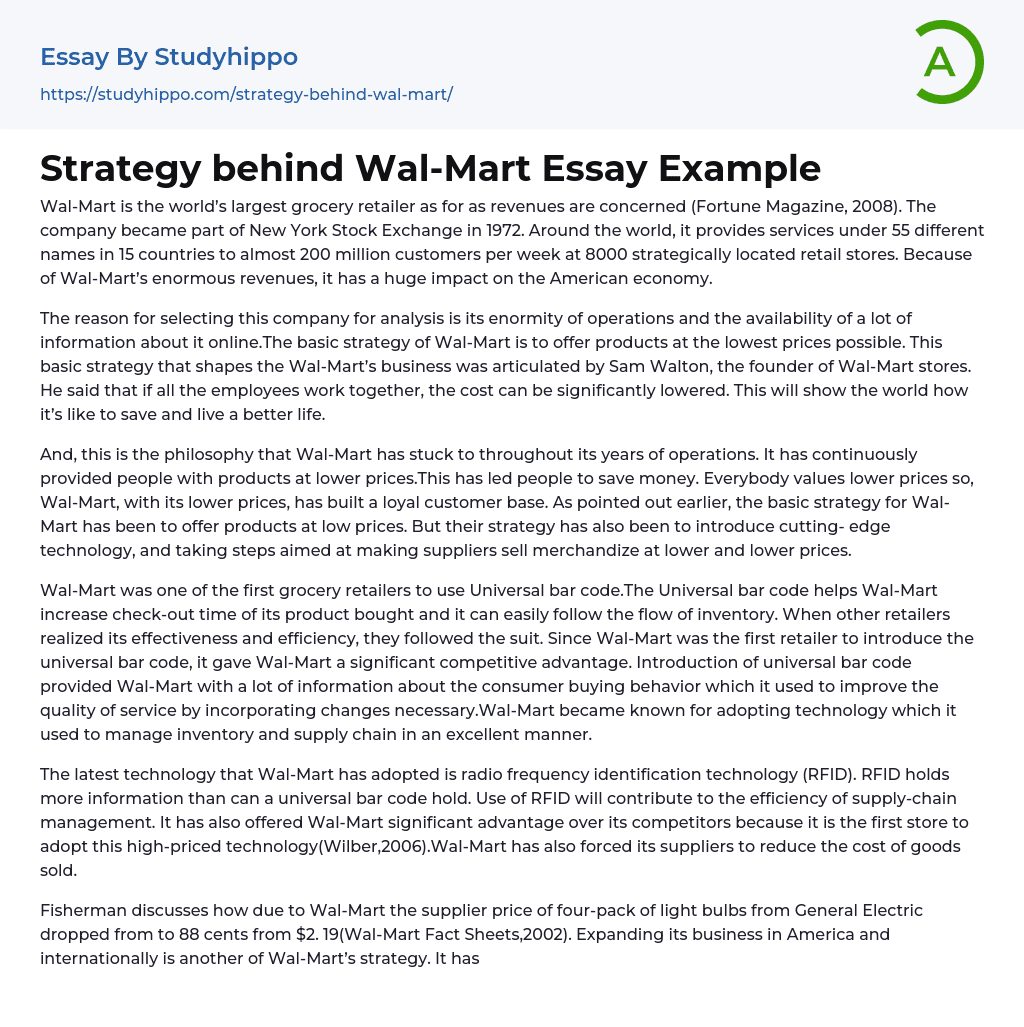As per Fortune Magazine's 2008 report, Wal-Mart holds the top spot as the biggest revenue-earning grocery retailer globally. Since its initial public offering on the New York Stock Exchange in 1972, it has expanded to operate under 55 different names across 15 countries. With an impressive network of approximately 8000 retail stores strategically placed worldwide, it caters to almost 200 million customers every week. Wal-Mart's significant earnings make it a major contributor to the American economy.
One of the primary factors for choosing this corporation for examination is its vast range of operations and abundance of online information. Wal-Mart's fundamental tactic involves providing goods at the most affordable prices, a plan introduced by Sam Walton, who started Wal-Mart stores. Walton believed that by collaborating as a team, workers could considerably decrease expenses while demonstrating to society the benefits of frugality and an improved standard of living.
>
Wal-Mart's strategy is focused on developing a loyal customer base through affordable products. This involves implementing a variety of tactics such as lowering prices, utilizing advanced technology and encouraging suppliers to provide even more cost-effective options.
Wal-Mart gained a competitive edge over other retailers by adopting the Universal bar code for grocery retail early on. This move improved their check-out time and inventory tracking, while also providing insights into consumer purchasing behavior that facilitated necessary changes and enhanced service quality. Wal-Mart has a well-established reputation for utilizing technology to manage its inventory and supply chain.
Wal-Mart has gained a competitive advantage over its rivals by utilizing radio frequency identification (RFID) technology. This innovation allows for the storage of more data than universal bar codes and improves supply-chain efficiency. Although expensive, Wal-Mart was the
first retailer to adopt RFID technology, as reported by Wilber in 2006. In addition, the company mandates that suppliers reduce their cost of goods sold.
Based on Wal-Mart Fact Sheets from 2002, the supplier price for a four-pack of General Electric light bulbs was reduced from $2.19 to 88 cents due to Wal-Mart's actions as depicted in The Fisherman. Furthermore, Wal-Mart is increasing its global business reach through the establishment of stores worldwide. Of the total 4,000 stores owned by Wal-Mart, 1,200 are situated outside of America.
In 2002, the Wal-Mart Factsheet revealed that the company operates in nine countries globally and focuses on promoting customer satisfaction through advertising campaigns to establish a positive reputation among consumers (Wilber, 2006). Their strategy centers around offering products at prices lower than competitors', with many customers reportedly saving around 15% on purchases.
The achievement has become possible thanks to Wal-Mart's utilization of advanced technology.
- Board Of Directors essays
- Brand Management essays
- Business Ethics essays
- Business Management essays
- Change Management essays
- Comparative Analysis essays
- Decision Making essays
- Dispute Resolution essays
- Knowledge Management essays
- Leadership essays
- Leadership and Management essays
- Manager essays
- Operations Management essays
- Performance Management essays
- Product Management essays
- Project Management essays
- Quality Management essays
- Risk essays
- Risk Management essays
- Scientific Management essays
- Stress Management essays
- supply chain management essays
- Time Management essays
- Total Quality Management essays
- Adidas essays
- Amazon essays
- Apple essays
- Bmw essays
- British Airways essays
- Burger King essays
- Coca-Cola essays
- Company essays
- Costco essays
- Dell essays
- Ebay essays
- Enron essays
- Facebook essays
- Ford Motor Company essays
- Gap essays
- General Motors essays
- Google essays
- Honda essays
- Ibm essays
- Ikea essays
- Intel essays
- Iphone essays
- Johnson and Johnson essays
- Kellogg essays
- Key essays
- Kfc essays




